History of Khajuraho – One thousand years ago, 85 extraordinary temples were constructed near Khajuraho under the patronage of the Chandella kings who ruled over the area from the 9th to the 14th century.
History of Khajuraho remains of only 25 of these temples survive.
Here we are showing 12 of them.
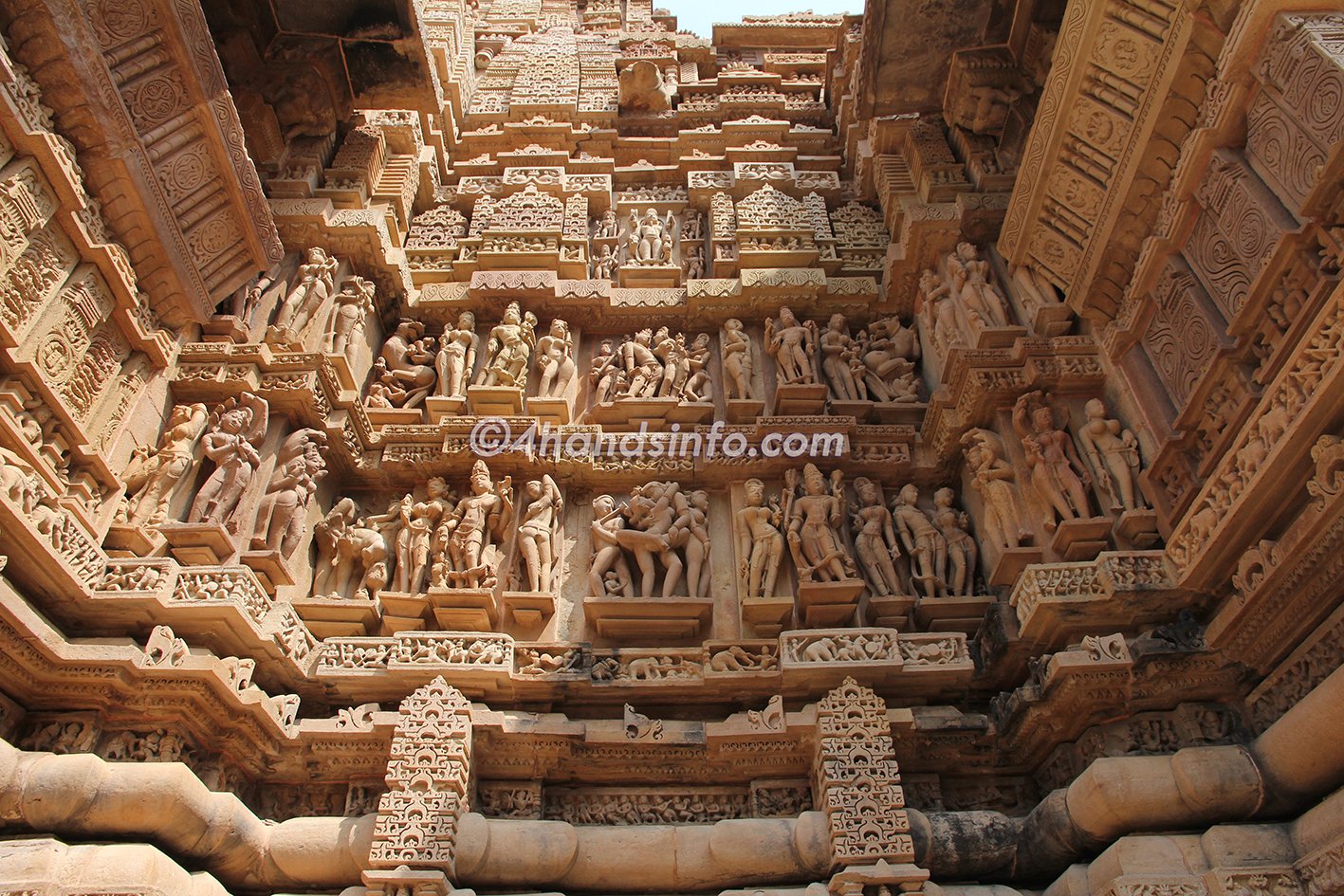
01. Chaturbhuj Temple
The Chaturbhuj Temple is a historic Hindu temple located in Orchha, Madhya Pradesh, India. Orchha itself is a town that boasts a remarkable collection of medieval architecture, and the Chaturbhuj Temple is among its most notable landmarks. This temple is dedicated to Vishnu, a major deity in Hinduism known for his role as the preserver and protector of the universe.
Architectural Significance
Structure and Design: The temple features a unique blend of temple and fort architecture, which is not very common. Its structure is massive, and it has a complex multistoried layout that includes large courtyards and a high shikhara (spire).
Built Date: Construction of the temple began in the 16th century during the reign of the Bundela Rajputs. It was specifically built to house an idol of Ram that, according to legend, however, remained in the Ram Raja Temple, another significant temple in Orchha.
Art and Sculpture: The temple walls and the interior are adorned with intricate carvings that depict various themes from Hindu mythology. Despite its dedication to Vishnu, the temple showcases a diverse range of deities and motifs, reflecting the syncretic cultural and religious influences of the time.
Cultural and Historical Context
Orchha’s Heritage: The Chaturbhuj Temple is part of the rich cultural and historical heritage of Orchha, which was once the capital of the Bundela kingdom. The town is known for its grand palaces, temples, and cenotaphs, which have survived in good condition to this day.
Religious Significance: Although initially intended for Lord Rama, the temple’s association with Vishnu still makes it an important place of worship and pilgrimage. Its name, Chaturbhuj, is a term that refers to the fourarmed form of Vishnu, symbolizing strength and power.
Tourism
The temple, along with the other historical structures of Orchha, attracts tourists and devotees alike. Visitors are often struck by the temple’s imposing architecture and its serene atmosphere. Its location on a raised platform offers panoramic views of the surrounding area, making it a popular spot for photography and sightseeing.
Preservation
Efforts have been made to preserve and maintain the Chaturbhuj Temple, along with Orchha’s other monuments, given their historical and architectural significance. These efforts ensure that the temple remains a vibrant part of India’s cultural heritage.
Visiting the Chaturbhuj Temple offers a glimpse into the rich tapestry of India’s history, religion, and architectural grandeur, making it a mustvisit for those exploring the heartland of India.
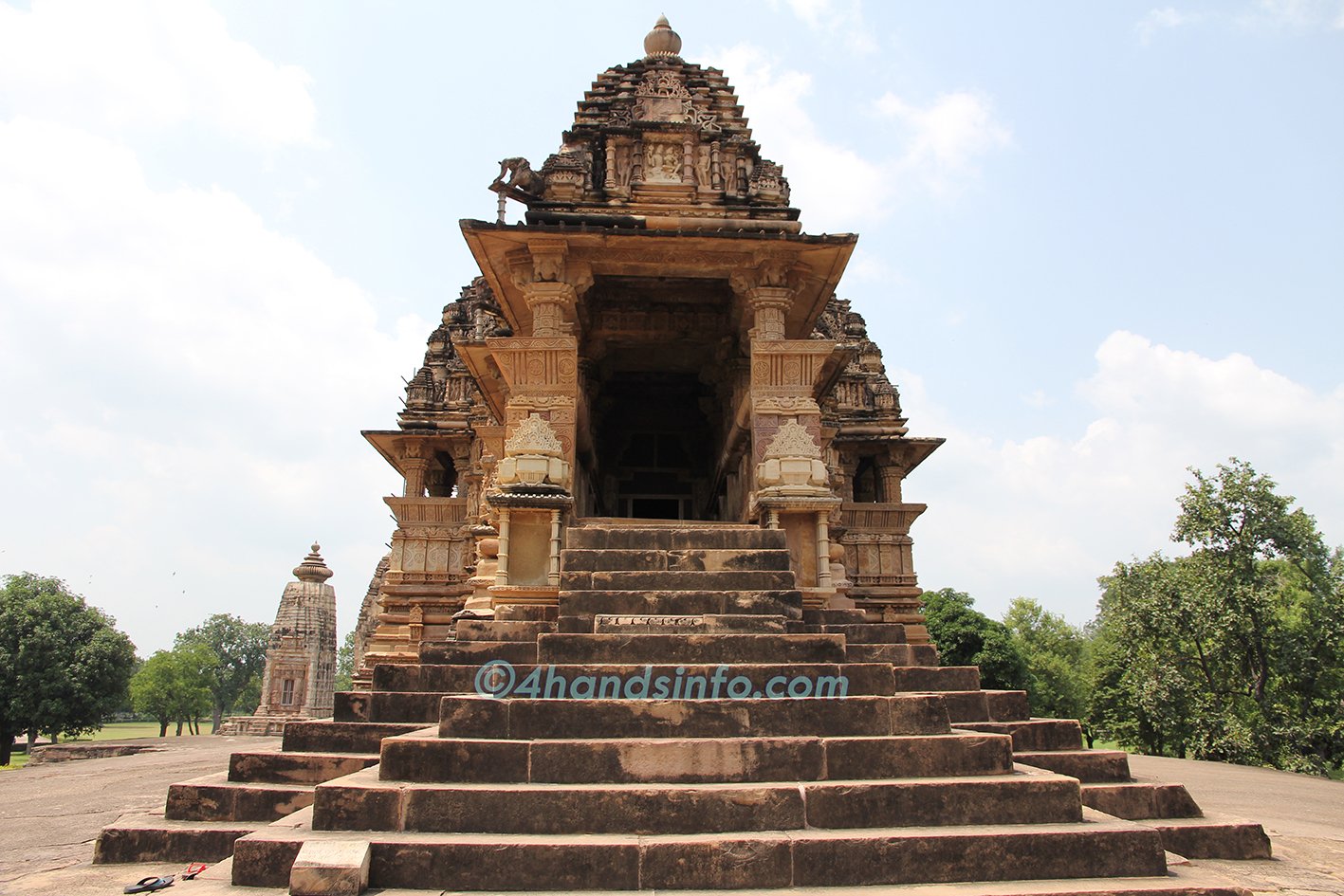
02. Duladeo Temple
Duladeo Temple, also known as “Duladeva” temple, is one of the temples located in the ancient city of Khajuraho in the Indian state of Madhya Pradesh. Khajuraho is renowned worldwide for its cluster of Hindu and Jain temples, which are recognized as a UNESCO World Heritage Site. These temples are celebrated for their intricate and exquisite architectural beauty, particularly their detailed erotic sculptures. However, the Duladeo Temple stands out for being more focused on the religious and mythological aspects rather than the erotic themes that are prevalent in some of the other temples within the complex.
Historical Context
Era: The Duladeo Temple is believed to have been built between 10001150 AD, during the later period of Chandela dynasty rule. This timing places it towards the end of the templebuilding frenzy in Khajuraho, making it one of the last temples constructed in the area.
Dedication: The temple is dedicated to Lord Shiva, one of the principal deities of Hinduism, worshipped here in the form of a Shivlinga.
Architectural Features
Layout: Following the architectural norms of Khajuraho temples, Duladeo features a series of structures including an entrance porch (ardhamandapa), a main assembly hall (mandapa), a vestibule (antarala), and the main sanctum (garbhagriha).
Style: The temple is built in the Nagara style of architecture, characterized by the beehiveshaped shikhara (spire) over the sanctum. The temple stands on a high platform, enhancing its majestic appearance.
Sculptures: While the temple’s sculptures lean more towards depicting various aspects of Shiva’s mythology and less towards erotic imagery, they are still intricate and exemplify the high craftsmanship of the Chandela era artisans. The temple walls are adorned with beautifully carved figures of apsaras (celestial nymphs), musicians, and other divine beings.
Cultural Significance
Religious Importance: The Duladeo Temple remains a site of worship and holds religious significance, particularly for devotees of Lord Shiva.
Artistic Heritage: It represents the culmination of the architectural and artistic endeavors of the Chandela period, showcasing the advanced level of sophistication achieved by the artisans of the time.
Conservation and Tourism
Preservation Efforts: Like other temples in Khajuraho, Duladeo has been the subject of preservation and conservation efforts to maintain its historical and architectural integrity.
Tourist Attraction: It attracts tourists and scholars from across the globe, interested in exploring India’s medieval architectural heritage and understanding the religious and cultural dynamics of the time.
The Duladeo Temple, with its serene setting and religious ambiance, offers a different perspective on the Khajuraho temple complex, highlighting the diversity in worship and architectural styles that flourished under the Chandela dynasty.
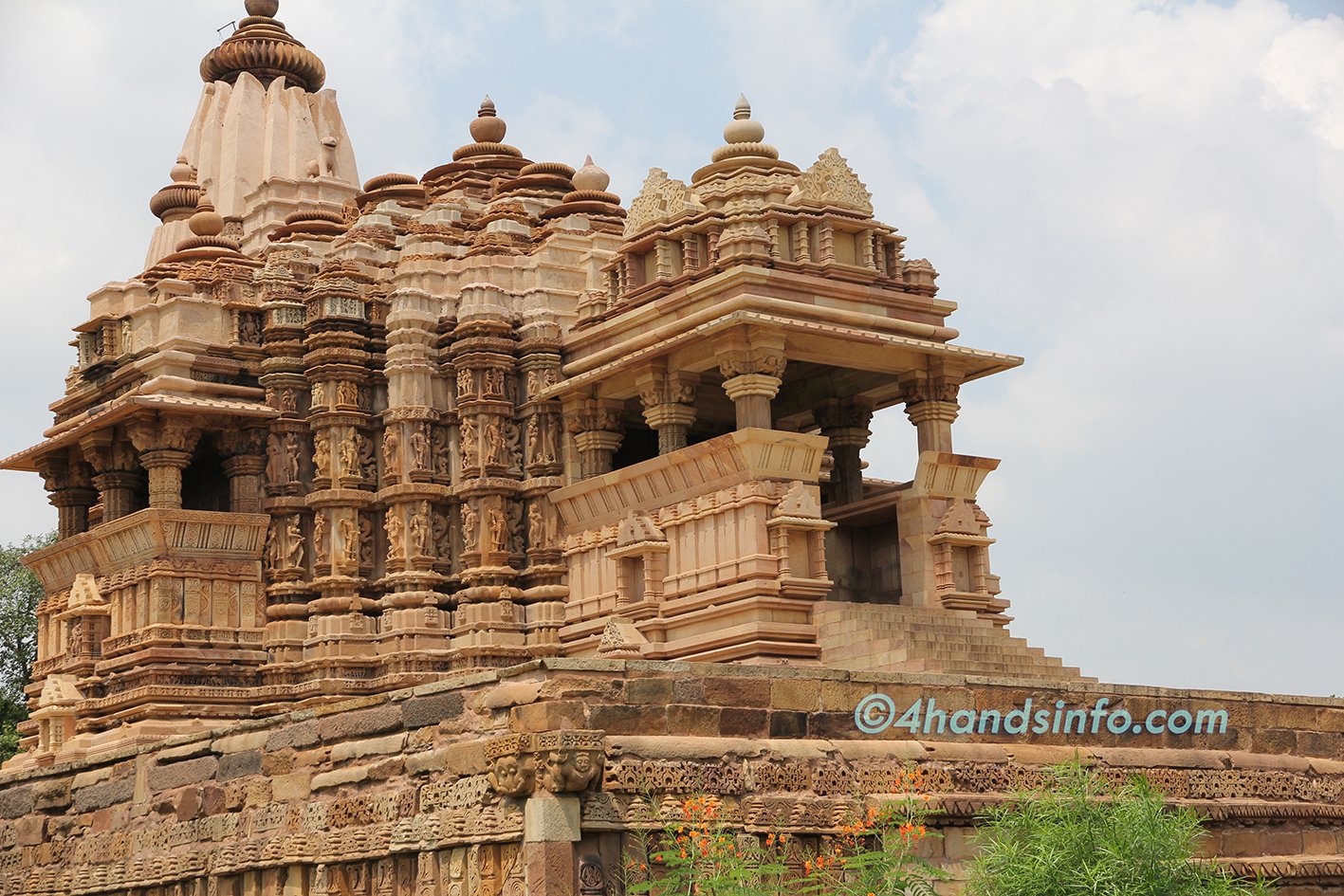
03. Brahma Temple
The Brahma Temple in Khajuraho is one of the lesserknown temples within the famous Khajuraho Group of Monuments in Madhya Pradesh, India. Despite its name, which suggests a dedication to the Hindu god Brahma, the creator god in the Hindu triumvirate (Trimurti), the temple is actually dedicated to Lord Vishnu. This confusion often arises due to the presence of a fourfaced linga enshrined within the temple, which led to the initial assumption that it was dedicated to Brahma, whose iconography typically includes four faces, looking in the four directions.
Location and Context
The Brahma Temple is located on the banks of the KhajurSagar or Ninora Tal, a small lake near the village of Khajuraho. This temple is part of the Eastern Group of Temples, which includes both Hindu and Jain temples. The Eastern Group is a bit removed from the larger, more famous Western Group of Temples that houses the majority of Khajuraho’s stunning monuments.
Architectural Features
Style: The temple is constructed in the granite stone, which is a departure from the sandstone typically used in the majority of Khajuraho’s temples. Its architectural style is consistent with the early medieval North Indian temple architecture, known as Nagara style.
Design: The structure of the Brahma Temple is simple compared to the elaborately decorated temples like Kandariya Mahadeva. It consists of a sanctum (garbhagriha) and an entrance porch (ardhamandapa), lacking the grand assembly halls (mandapas) seen in other Khajuraho temples.
Sculptures: The temple features fewer sculptures than its counterparts in the complex, and the themes are more restrained, focusing on religious iconography rather than the amorous and intricate scenes for which Khajuraho is renowned.
Historical Significance
The Brahma Temple is believed to have been constructed around the 9th century, making it one of the older temples in the Khajuraho complex. Its dedication to Vishnu and the unique fourfaced linga it houses add an interesting dimension to the religious landscape of Khajuraho, reflecting the diversity of worship and the syncretic religious practices of the time.
Conservation and Tourism
As part of the Khajuraho Group of Monuments, the Brahma Temple is recognized by UNESCO as a World Heritage Site. This designation has helped in conservation efforts, ensuring that the temple, along with others in the complex, is preserved for future generations. While it may not attract the same level of attention as the more elaborate temples in Khajuraho, the Brahma Temple offers visitors a quieter, reflective space to appreciate the ancient architectural and religious traditions of India.
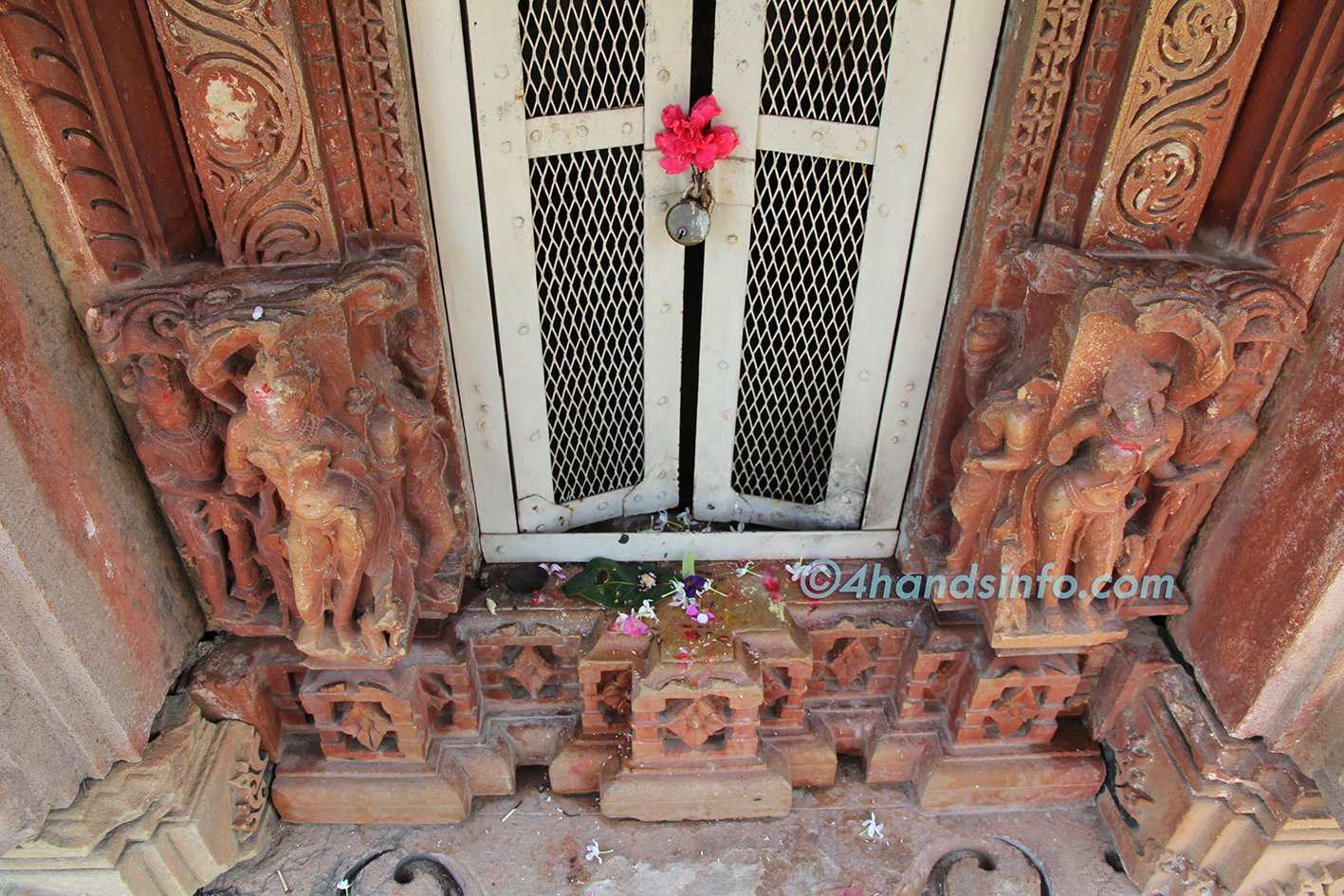
04. Vamana Temple
The Vamana Temple in Khajuraho, Madhya Pradesh, India, is one of the remarkable temples in the Eastern Group of the Khajuraho Group of Monuments, and known for its stunning temples with intricate sculptures and architectural beauty. The temple is dedicated to Vamana, the fifth avatar of Vishnu, who is depicted in Hindu mythology as a dwarf brahmin who restores cosmic order by reclaiming the universe from the demon king Bali through his three steps.
Architectural Features
Style and Design: The Vamana Temple is a fine example of Nagara style architecture, characterized by its beehiveshaped tower (shikhara) and almost vertical projections that run the height of the temple. Like many other temples in Khajuraho, it is built on a high platform known as a jagati, which adds to its majestic appearance. The temple’s layout includes a sanctum (garbhagriha), a vestibule (antarala), and a porch (mandapa), but it lacks the large assembly hall (mahamandapa) found in some of the larger temples.
Sculptures: The exterior walls of the temple are adorned with numerous sculptures depicting various deities, apsaras (celestial maidens), and scenes from daily life and mythology. The carvings are noted for their detail and the skillful artistry of the Chandela craftsmen. The themes of the sculptures range from the purely religious to the secular, reflecting a wide spectrum of life and beliefs.
Historical Context
Construction: The Vamana Temple is believed to have been built around the early 11th century during the reign of the Chandela dynasty, which was known for promoting art, architecture, and culture, leading to the construction of the Khajuraho temples.
Dedication: Unlike many of the other temples in Khajuraho, which are dedicated to Shiva, Vishnu, or Jain Tirthankaras, the Vamana Temple specifically honors the Vamana avatar of Vishnu, showcasing the diversity of worship and religious expression prevalent in medieval India.
Cultural and Religious Significance
The temple serves as an important site for the study of ancient Hindu architecture and iconography. It reflects the theological and philosophical beliefs of the time, emphasizing the omnipresence and versatility of Vishnu.
The depiction of Vamana, a less commonly worshipped form of Vishnu, highlights the inclusive nature of Hinduism, where various forms and narratives of the divine are celebrated.
Conservation and Tourism
As part of the Khajuraho Group of Monuments, the Vamana Temple benefits from efforts by the Archaeological Survey of India and UNESCO to preserve and maintain these historic sites.
It attracts scholars, history enthusiasts, and tourists from around the world, drawn by its historical significance, architectural beauty, and the peaceful ambiance that contrasts with the more visited Western Group of Temples.
Visiting the Vamana Temple offers a unique opportunity to delve into the rich tapestry of medieval Indian culture, where architecture and sculpture come together to narrate stories of divine incarnations and cosmic order.
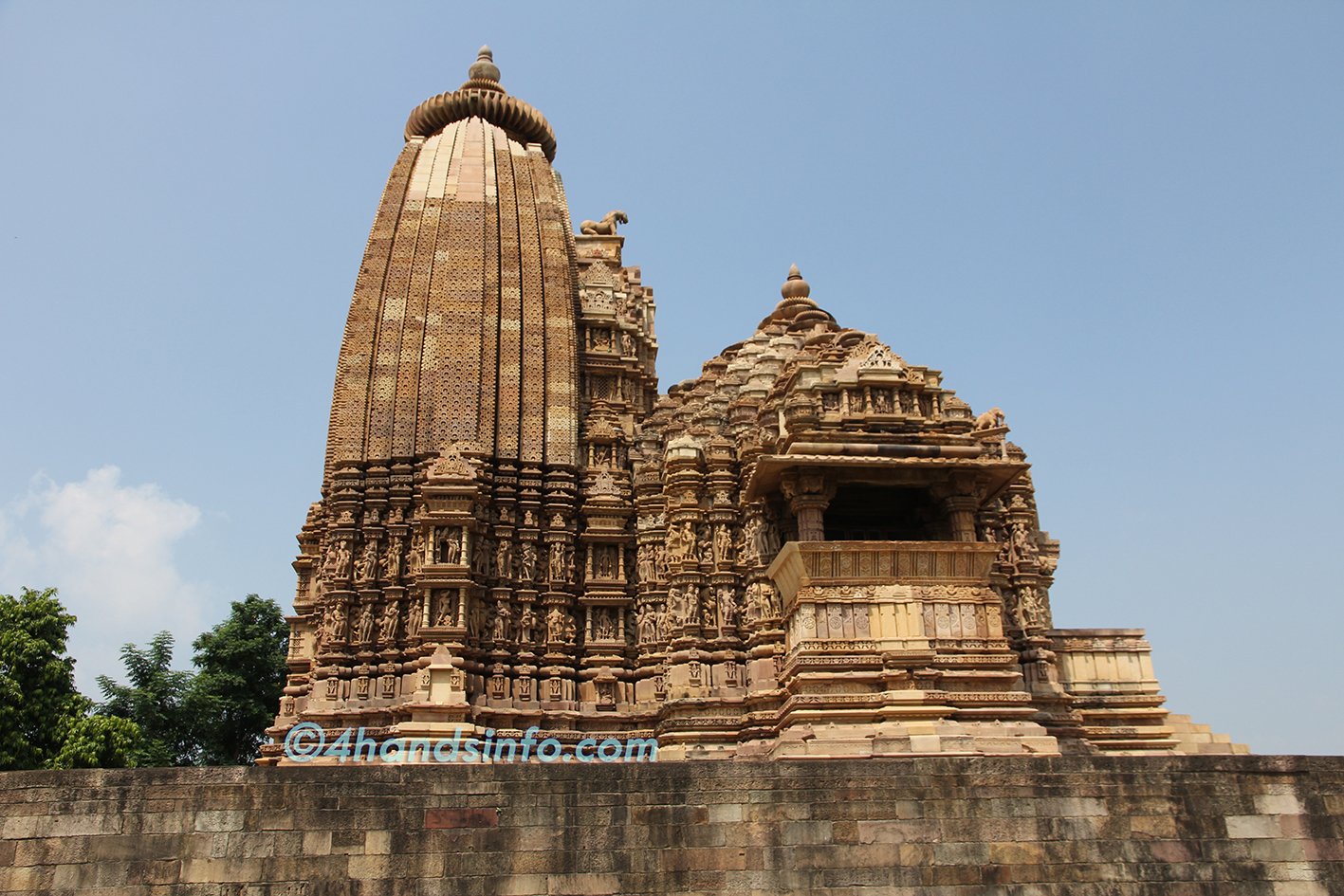
05. Parsvanatha Temple
The Parsvanatha Temple is one of the prominent Jain temples located in Khajuraho, Madhya Pradesh. And its stunning array of temples that exhibit the architectural and artistic grandeur of medieval India. Unlike the majority of the temples at Khajuraho, which are predominantly Hindu and dedicated to various deities of the Hindu pantheon, the Parsvanatha Temple is dedicated to Lord Parsvanatha, the 23rd Tirthankara of Jainism.
Architectural Features
Style: The temple is built in the Nagara style, which is characteristic of medieval north Indian temple architecture. It features a shikhara (spire) that rises above the sanctum, and several smaller subsidiary spires that cluster around the main spire.
Layout: The temple’s design includes a sanctum (garbhagriha), a vestibule (antarala), and a porch (mandapa), but it lacks the large congregational hall (mahamandapa) found in some other temples. The temple stands on a high platform, enhancing its majestic appearance.
Sculptures: The exterior walls of the Parsvanatha Temple are adorned with exquisite sculptures depicting various figures, including Jain tirthankaras, celestial beings (apsaras), and intricate floral and geometric patterns. The sculptures are noted for their detail, beauty, and expressiveness, showcasing the craftsmanship of the Chandela period artisans.
Historical Context
Construction: The Parsvanatha Temple is believed to have been constructed in the mid10th century, making it one of the later additions to the Khajuraho complex. Its dedication to a Jain Tirthankara reflects the pluralistic religious landscape of medieval India, where Jainism and Hinduism coexisted and influenced each other.
Dedication: Though originally dedicated to Lord Parsvanatha, the temple now houses an image of Lord Suparshvanatha, the 7th Tirthankara, indicating changes in religious practices and iconography over time.
Cultural and Religious Significance
Jain Heritage: The Parsvanatha Temple is an important site for understanding Jain religious practices, iconography, and temple architecture. It represents the significant presence and patronage of Jainism in the region during the medieval period.
Artistic Achievement: The temple’s sculptures and architectural design contribute to our understanding of the cultural and artistic achievements of the Chandela dynasty, under whose patronage the Khajuraho temples were constructed.
Conservation and Tourism
Preservation Efforts: As part of the Khajuraho Group of Monuments, the Parsvanatha Temple benefits from ongoing conservation efforts by the Archaeological Survey of India and UNESCO to preserve the site for future generations.
Tourist Attraction: It attracts tourists, scholars, and Jain pilgrims from around the world, drawn by its historical significance, architectural beauty, and the serene atmosphere of the temple complex.
Visiting the Parsvanatha Temple offers a unique glimpse into the religious diversity of medieval India, as well as the opportunity to appreciate the exquisite artistry and architectural innovation of the time.
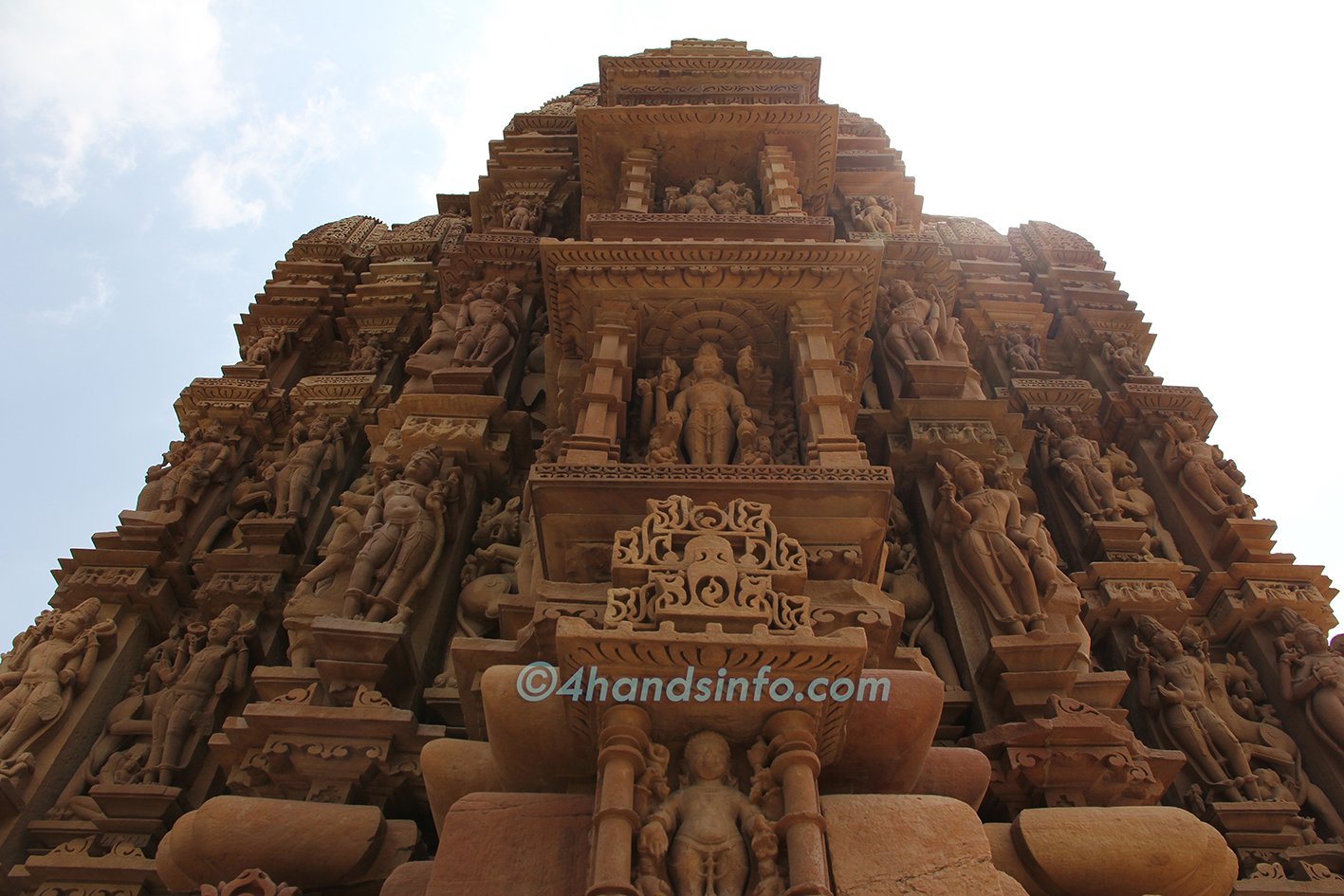
06. Adinatha Temple
The Adinatha Temple in Khajuraho, renowned for their architectural beauty and intricate sculptures. located in Madhya Pradesh, India. While Khajuraho is predominantly known for its Hindu temples, the Eastern Group contains a few significant Jain temples, among which the Adinatha Temple holds a place of importance. The temple is dedicated to Adinatha, also known as Rishabhanatha, who is the first Tirthankara (spiritual teacher) of Jainism.
Architectural Features
Style: The Adinatha Temple follows the Nagara style of temple architecture, which is characterized by its beehiveshaped shikhara (tower). This style is prevalent among the temples in Khajuraho, signifying a common architectural tradition despite the diversity of deities worshipped.
Design: Although smaller and less elaborate than some of the larger temples in Khajuraho, the Adinatha Temple features a sanctum (garbhagriha) with a vestibule (antarala), and a porch (mandapa), but, like many Jain temples, it does not include a large congregational hall (mahamandapa).
Sculptures: The temple’s exterior walls are adorned with exquisite sculptures that include depictions of Jain Tirthankaras and various celestial figures, showcasing the finesse of Chandela artistry. The sculptures on the Adinatha Temple are noted for their delicate detail and spiritual expression, reflecting Jain values and themes.
Historical Context
The Adinatha Temple is believed to have been built in the late 11th to early 12th century, during the decline of the Chandela dynasty’s power. This period saw the construction of several Jain temples in the Khajuraho complex, indicating a significant Jain community presence and influence in the region.
Cultural and Religious Significance
Jain Heritage: The temple is an important monument for the Jain community, showcasing the rich religious and cultural heritage of Jainism. It serves as a reminder of the peaceful coexistence and mutual respect among different religious traditions in medieval India.
Artistic Achievement: Despite its smaller size, the Adinatha Temple contributes significantly to the artistic landscape of Khajuraho, offering insights into the iconography and artistic conventions of Jain religious art.
Conservation and Tourism
Preservation Efforts: Being part of the Khajuraho Group of Monuments, the Adinatha Temple benefits from the conservation and preservation efforts undertaken by the Archaeological Survey of India and UNESCO. These efforts ensure the temple’s structural and artistic integrity for future generations.
Tourist Attraction: The temple attracts tourists, art historians, and Jain pilgrims, who come to admire its serene beauty, spiritual ambiance, and the detailed artistry of its sculptures.
The Adinatha Temple, with its spiritual significance and artistic beauty, offers a distinct perspective on the religious and cultural diversity of the Khajuraho temple complex, highlighting the Jain contribution to this unique UNESCO World Heritage Site.
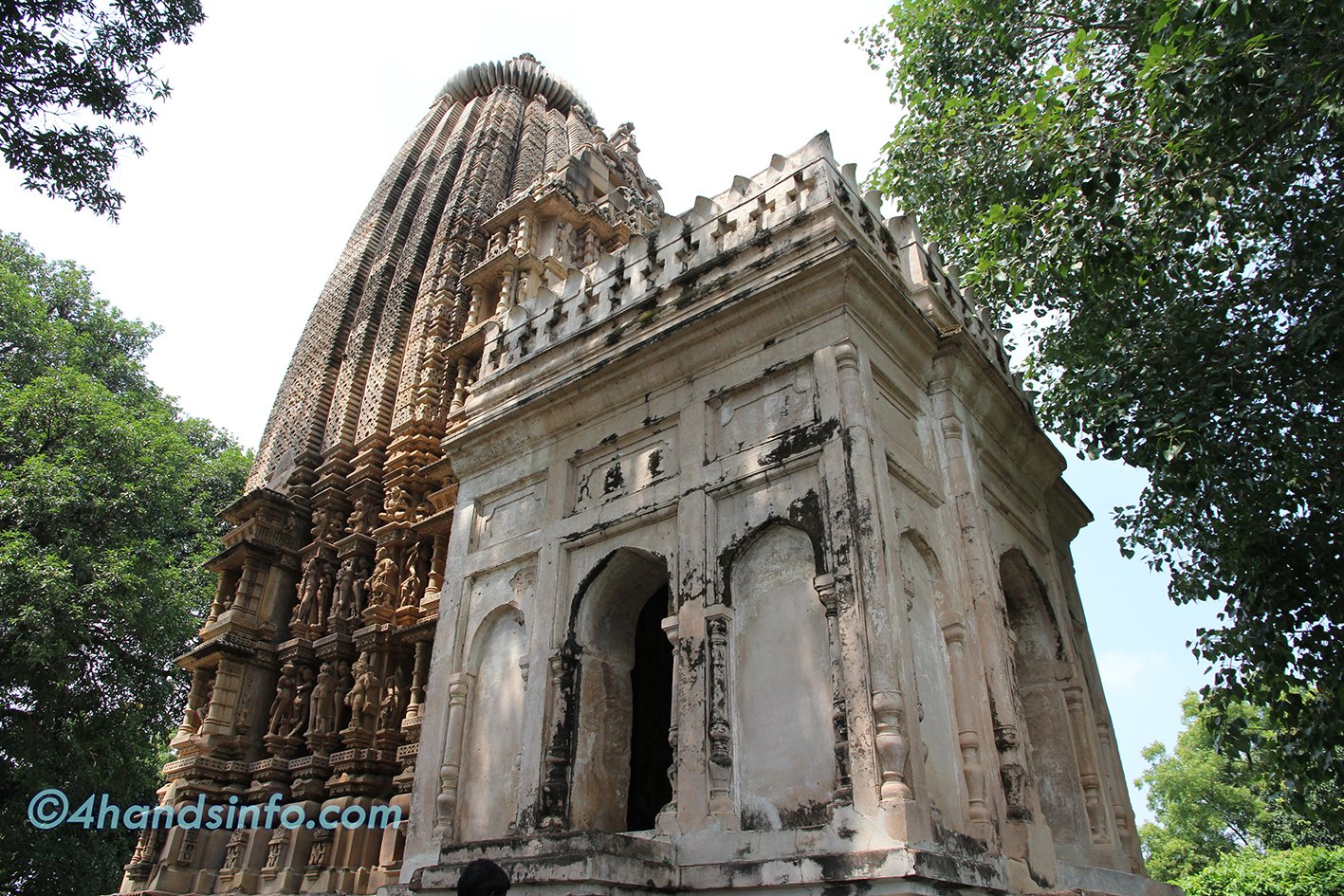
07. Vishvanatha Temple
The Vishvanatha Temple is one of the most celebrated temples located in Madhya Pradesh, India. It is renowned for its architectural marvels and intricate sculptures that date back to the medieval period. Dedicated to Lord Shiva, the Vishvanatha Temple stands out for its remarkable craftsmanship, spiritual significance, and architectural beauty.
Architectural Features
Style: The temple is a splendid example of Nagarastyle architecture, characterized by its tall and elaborately carved shikhara (spire), which is meant to represent Mount Meru, the mythological center of the universe in Hindu, Jain, and Buddhist cosmology.
Layout: The Vishvanatha Temple features a sophisticated layout, including a sanctum (garbhagriha) with a lingam (a symbol of Lord Shiva), an antarala (vestibule), a mahamandapa (grand hall), and an ardhamandapa (entrance porch). It is built on a high plinth and adorned with a series of subsidiary shrines, which adds to its grandeur.
Sculptures: The temple walls are profusely decorated with intricate carvings that include a variety of themes ranging from divine figures to amorous couples (mithunas), apsaras (celestial maidens), and scenes from daily life. The sculptures also feature various manifestations of Lord Shiva and stories from Hindu mythology, showcasing the artisans’ exceptional skill and deep religious understanding.
Historical Context
The Vishvanatha Temple was built during the reign of the Chandela dynasty, attributed to King Dhanga, who ruled from the late 10th to the early 11th century. The temple’s construction reflects the prosperity and artistic zenith of the Chandelas, who were patrons of art and architecture and established Khajuraho as a major cultural center.
Cultural and Religious Significance
Spiritual Center: Dedicated to Lord Shiva, the temple serves as an important spiritual site, attracting devotees and scholars interested in Shaivism, one of the major traditions within Hinduism.
Artistic Achievement: The temple is celebrated for its architectural design and the sheer density of its sculptural decorations, which are considered masterpieces of Indian art. The sculptures not only depict the divine but also celebrate human expression, emotions, and the beauty of life.
Symbolism: The architectural and sculptural elements of the Vishvanatha Temple are rich in symbolic meanings, reflecting Hindu philosophy, theology, and cosmology.
Conservation and Tourism
Preservation Efforts: As part of the Khajuraho Group of Monuments, the Vishvanatha Temple benefits from ongoing conservation efforts by the Archaeological Survey of India (ASI) and UNESCO. These efforts aim to preserve the temple’s structural integrity and artistic heritage for future generations.
Tourist Attraction: The temple is a major attraction for tourists from around the world, drawn by its historical significance, architectural beauty, and the opportunity to experience the spiritual and cultural ambiance of Khajuraho.
The Vishvanatha Temple stands as a testament to the religious devotion, artistic innovation, and cultural richness of medieval India, making it a key highlight of the Khajuraho temple complex.
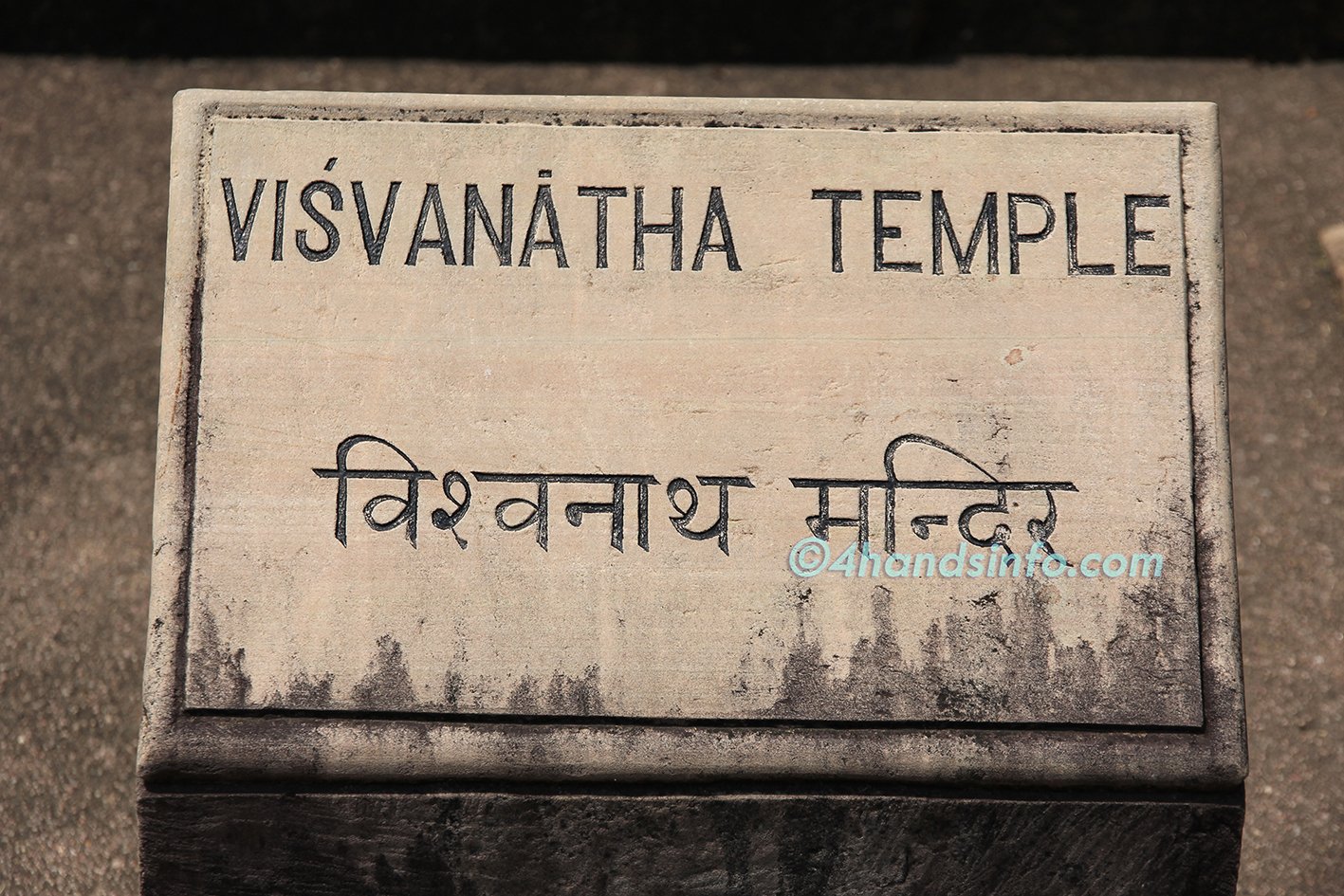
08. Devi Jagdambi Temple
The Devi Jagdambi Temple, part of the renowned Khajuraho Group of Monuments in Madhya Pradesh, India, is a splendid example of medieval temple architecture and artistry. It is famous for its architectural marvels and intricate sculptures. The Devi Jagdambi Temple, though smaller than the Kandariya Mahadeva Temple, is significant for its beautifully detailed sculptures and spiritual importance. It is located in the Western Group of Temples, which are the most prominent and visited group in the Khajuraho complex.
Architectural Features
Style: The temple is built in the Nagara style of Hindu temple architecture, characteristic of North India, featuring a beehiveshaped shikhara (tower) that rises gracefully above the sanctum. The temple layout includes a sanctum (garbhagriha), a vestibule (antarala), and a porch (mandapa), all built on a high platform called jagati, which is a common feature in many Khajuraho temples.
Sculptures: The temple’s exterior walls are adorned with a plethora of exquisite sculptures. Unlike many other temples at Khajuraho that exhibit a wide array of themes, the Devi Jagdambi Temple is particularly noted for its finely carved figures of apsaras (celestial maidens) and surasundaris (beautiful women) in various postures and activities. It also houses remarkable sculptures of gods and goddesses from the Hindu pantheon.
Historical Context
The exact date of the temple’s construction is not definitively known, but it is generally believed to have been built in the late 10th or early 11th century during the reign of the Chandela dynasty. Initially, it might have been dedicated to Vishnu, as suggested by the presence of a Vaishnavite image in the sanctum. However, the temple is now dedicated to the goddess Parvati, worshipped here as Devi Jagdambi (a name for Kali, a form of Parvati).
Cultural and Religious Significance
Deity Worship: The shift in the primary deity from Vishnu to Devi Jagdambi reflects the adaptability and syncretism in Hindu worship practices. The temple serves as an important site for devotees of the goddess, embodying her as the universal mother and protector.
Artistic Excellence: The temple’s sculptures are celebrated for their artistic brilliance, showcasing the mastery of Chandela artisans in stone carving. These sculptures not only depict divine themes but also capture the beauty and grace of human expressions and emotions.
Symbolism: Like other temples in Khajuraho, the Devi Jagdambi Temple’s architectural and sculptural elements are rich in symbolic meanings, reflecting themes of spirituality, temporal life, and the divine.
Conservation and Tourism
Preservation Efforts: The Devi Jagdambi Temple, along with the rest of the Khajuraho monuments, has been the focus of preservation and conservation efforts by the Archaeological Survey of India (ASI) and UNESCO. These efforts aim to maintain the structural integrity and artistic heritage of this historical site.
Tourist Attraction: The temple is a major attraction for tourists, historians, and art lovers from around the world. Visitors are drawn to its spiritual significance, architectural beauty, and the opportunity to witness the exceptional craftsmanship of its sculptures.
The Devi Jagdambi Temple stands as a testament to the religious, cultural, and artistic achievements of medieval India, offering visitors a glimpse into the rich traditions and heritage of the Chandela dynasty.
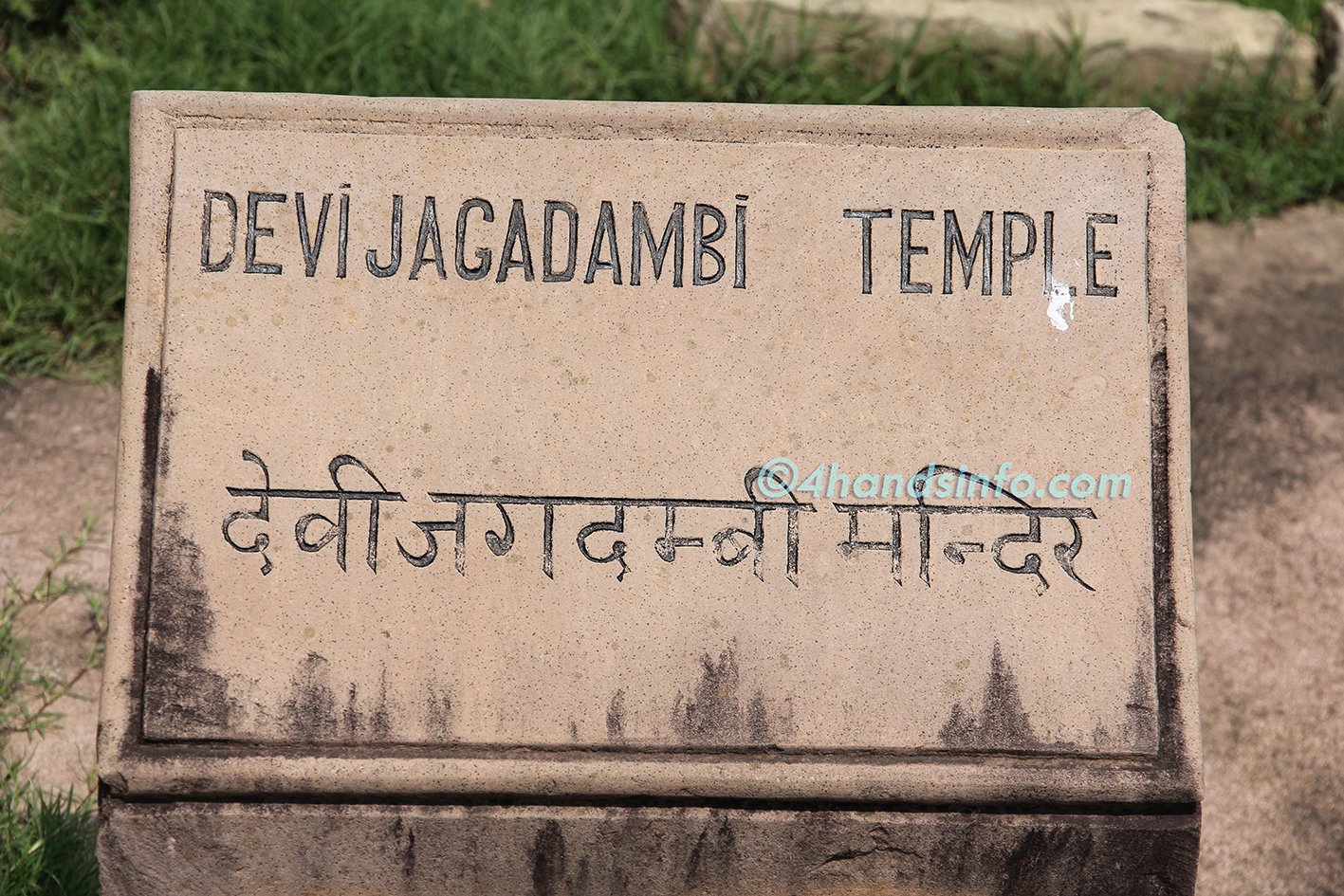
09. Kandariya Mahadeva Temple
The Kandariya Mahadeva Temple stands as the largest and most ornate temple located in Madhya Pradesh, India. it is celebrated for its architectural grandeur and intricate sculptures, representing the zenith of North Indian temple architecture under the Chandela dynasty. Dedicated to Lord Shiva, the temple is a pinnacle of medieval Hindu architecture and art, reflecting both the spiritual and earthly aspects of human life.
Architectural Features
Style: The Kandariya Mahadeva Temple exemplifies the Nagara style of architecture, characterized by its high shikhara (spire), which is meant to resemble Mount Meru, the mythological center of the universe in Hindu, Jain, and Buddhist cosmologies. The temple complex includes several structures, including a main shrine (garbhagriha) with a lingam, an entrance porch (ardhamandapa), a main assembly hall (mahamandapa), and a vestibule (antarala) connecting the sanctum to the assembly hall.
Layout: The temple stands on a high platform (jagati), enhancing its majestic appearance. Its plan is complex and harmoniously integrates the main temple with several subsidiary shrines, all intricately carved.
Sculptures: The exterior walls of the temple are adorned with a profusion of sculptures that number in the hundreds. These artworks depict various deities, celestial maidens (apsaras), mythical creatures, and scenes of everyday life, along with mithuna (erotic) sculptures that have made Khajuraho famous. The sculptures are renowned for their dynamism, realism, and intricate detailing, showcasing the pinnacle of Chandela artistry.
Historical Context
Constructed between 1025 and 1050 CE during the reign of King Vidyadhara, the Kandariya Mahadeva Temple is believed to celebrate the Chandela dynasty’s victories over rival kingdoms. The temple’s construction coincides with a period of great political and military success for the Chandelas, and it serves as a monumental expression of their power and religious devotion.
Cultural and Religious Significance
Spiritual Center: The temple serves as a profound symbol of Shaivism, dedicated to Lord Shiva, one of the principal deities in Hinduism. It represents the cosmic and spiritual dimensions of Shiva, embodying themes of creation, preservation, and destruction.
Artistic Mastery: The Kandariya Mahadeva Temple is celebrated as a masterpiece of Indian medieval architecture and sculpture, highlighting the advanced artistic skills and sophisticated aesthetic sensibilities of its creators.
Cultural Heritage: The temple’s elaborate sculptural program, encompassing both the sacred and the profane, offers insight into the societal values, spiritual beliefs, and everyday life of 11thcentury India, making it a vital source for historians and scholars.
Conservation and Tourism
Preservation Efforts: As part of the Khajuraho Group of Monuments, the Kandariya Mahadeva Temple benefits from ongoing conservation efforts by the Archaeological Survey of India and UNESCO. These efforts aim to preserve the temple’s architectural and artistic integrity for future generations.
Tourist Attraction: The temple attracts visitors from around the globe, drawn by its historical significance, architectural beauty, and the unique opportunity to experience the legacy of the Chandela dynasty’s artistic and spiritual expressions.
The Kandariya Mahadeva Temple not only embodies the pinnacle of medieval Hindu temple architecture but also serves as a profound symbol of India’s rich cultural and spiritual heritage.
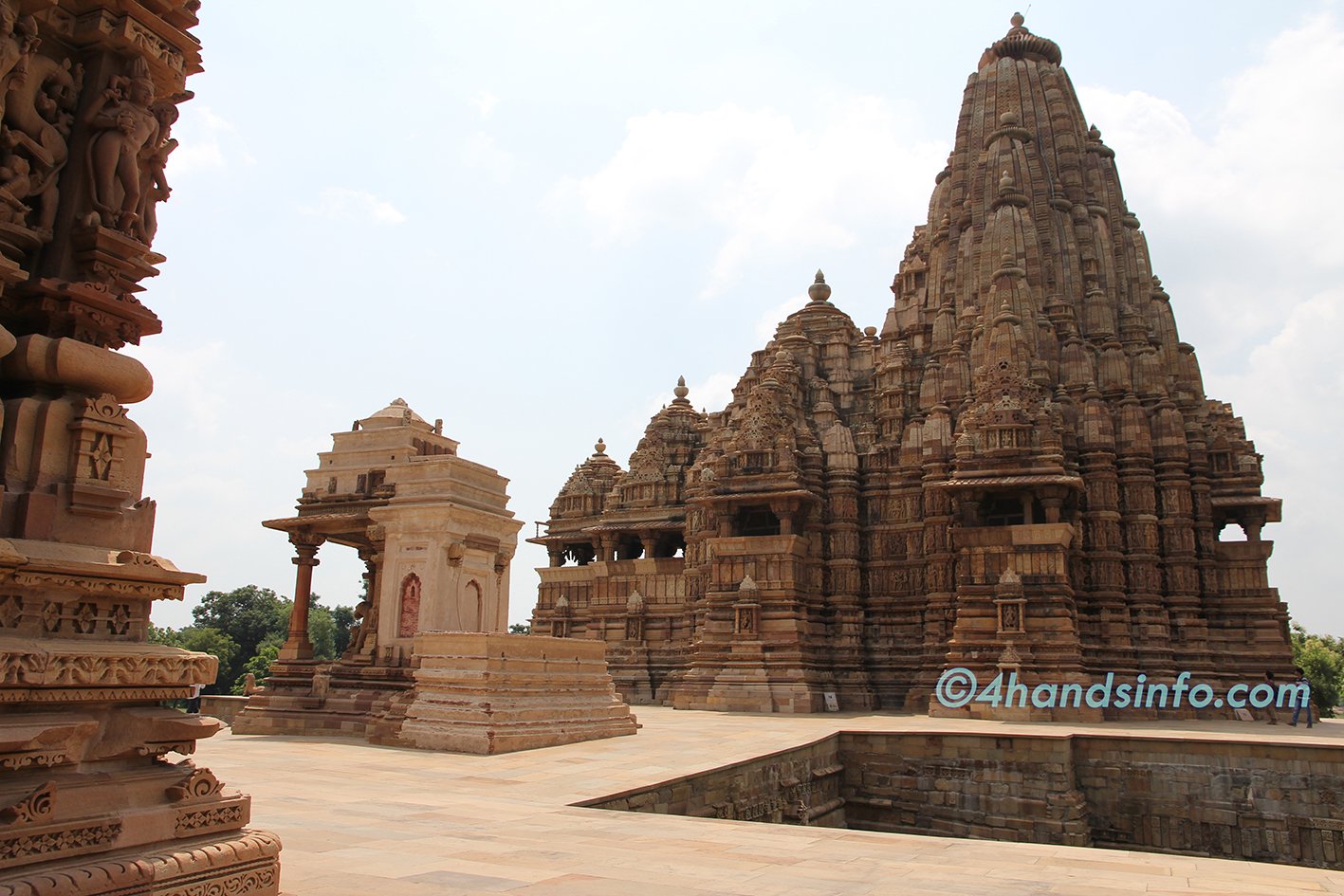
10. Varaha Temple
The Varaha Temple at Khajuraho is one of the smaller yet significant temples located in Madhya Pradesh, India. This temple is dedicated to Varaha, the third avatar of the Hindu god Vishnu, who is depicted in the form of a boar. The temple stands out for its simplicity and the remarkable sculpture of Varaha that it houses.
Architectural Features
Structure: Unlike the larger and more ornate temples in Khajuraho, the Varaha Temple is relatively modest in its architectural design. It does not have the towering shikharas (spires) or elaborate mandapas (halls) seen in other temples. Instead, it features a simple, rectangular platform that houses the idol.
Sculpture: The primary attraction of the temple is the monolithic sculpture of Varaha. This colossal image is intricately carved from a single piece of sandstone. The sculpture is remarkable for its detailed depiction of Varaha, with the entire surface of the body covered in a myriad of small carvings representing various Hindu deities and mythological figures, showcasing the skill and intricacy of the temple’s artisans.
Historical Context
The Varaha Temple dates back to approximately the 9th to 10th century CE, making it one of the earlier constructions in the Khajuraho complex. It reflects the religious syncretism and artistic experimentation that characterized the early phase of Chandela architectural development.
Cultural and Religious Significance
Avatar of Vishnu: The Varaha avatar of Vishnu has significant religious symbolism in Hinduism, representing the triumph of good over evil. According to Hindu mythology, Varaha saved the Earth from the demon Hiranyaksha, who had submerged it in the cosmic ocean. Varaha lifted the Earth out of the ocean with his tusks, restoring it to its rightful place in the universe.
Artistic Excellence: The detailed carvings on the Varaha sculpture are a testament to the high level of artistic achievement during the Chandela period. The depiction of numerous deities on its body serves as a pantheon of the Hindu gods and goddesses, reflecting the inclusive nature of Hindu worship.
Cultural Heritage: The temple contributes to the understanding of the cultural and religious milieu of medieval India, showcasing the diverse themes that characterized the spirituality and artistic expressions of the time.
Conservation and Tourism
Preservation: As part of the Khajuraho Group of Monuments, the Varaha Temple benefits from conservation efforts undertaken by the Archaeological Survey of India and UNESCO to preserve its historical and cultural significance.
Tourist Attraction: While it may not attract the same level of attention as some of the larger temples in Khajuraho, the Varaha Temple is nonetheless a significant site for visitors interested in Hindu mythology, religious art, and the architectural diversity of the Khajuraho complex.
The Varaha Temple offers a unique glimpse into the religious and artistic traditions of the Chandela dynasty, making it an integral part of the rich cultural tapestry of Khajuraho.
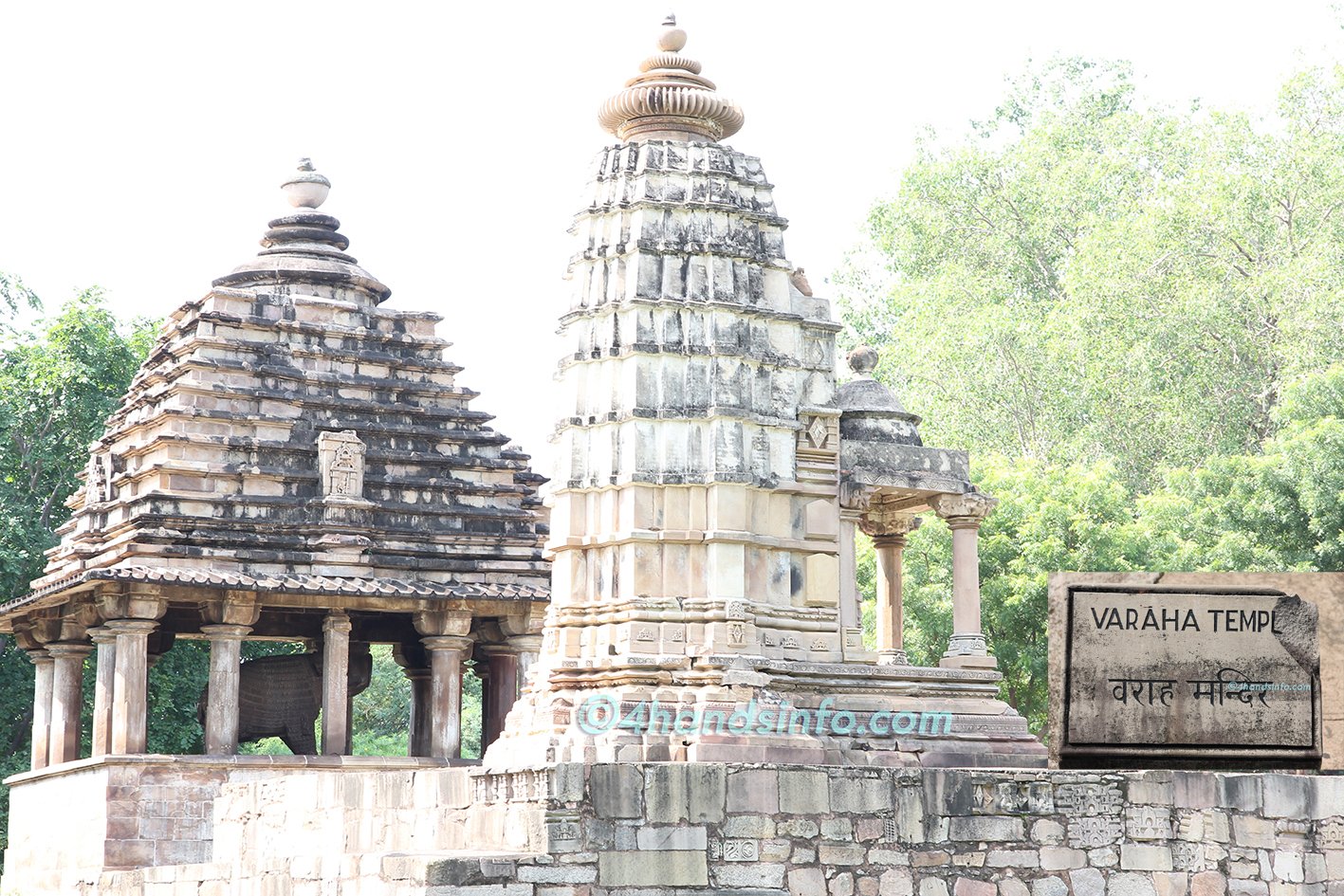
11. Lakshmana Temple
The Lakshmana Temple is one of the most exquisite temples located in Madhya Pradesh, India; it is celebrated for its magnificent architecture, intricate sculptures, and rich iconography. Dedicated to Lord Vishnu, the Lakshmana Temple stands as a remarkable example of the maturity and sophistication of medieval Hindu temple architecture under the patronage of the Chandela dynasty.
Architectural Features
Style: The temple is a brilliant example of Nagarastyle architecture, characterized by its beehiveshaped shikhara (spire). It features several bands of intricate carvings and a series of smaller subsidiary spires that rise up to the main spire, creating a visually harmonious effect.
Layout: The temple structure includes a sanctum (garbhagriha) housing an image of Vishnu, an entrance porch (ardhamandapa), a main assembly hall (mahamandapa), and a vestibule (antarala) connecting the sanctum to the assembly hall. The entire temple complex is elevated on a high platform (jagati), which is a distinctive feature of many temples in Khajuraho.
Sculptures: The exterior walls of the Lakshmana Temple are adorned with a plethora of sculptures depicting various deities, mythological scenes, and mithuna (erotic) figures. The temple is renowned for its highquality artistic sculptures that showcase the finesse of Chandela artistry. The carvings include images of Vishnu in his various avatars, as well as other gods and goddesses from the Hindu pantheon.
Historical Context
The Lakshmana Temple was built in the 10th century CE, around 930950 CE, during the reign of the Chandela ruler Yasovarman. It is one of the earliest and most finely decorated temples in the Khajuraho complex, reflecting the high point of Chandela architectural and artistic achievement.
Cultural and Religious Significance
Devotion to Vishnu: The temple’s dedication to Vishnu and the presence of various avatars of Vishnu within its sculptures highlight the religious importance of Vaishnavism (the worship of Vishnu) during the period of its construction.
Artistic Excellence: The Lakshmana Temple is a masterpiece of Indian art and architecture, exemplifying the skill and creativity of its builders. The detailed and diverse sculptures provide insight into the religious, cultural, and social life of medieval India.
Symbolism: The architectural layout and iconography of the temple reflect the Hindu cosmological themes of creation, preservation, and destruction, as well as the eternal cycles of time.
Conservation and Tourism
Preservation Efforts: As a part of the Khajuraho Group of Monuments, the Lakshmana Temple is protected by the Archaeological Survey of India (ASI) and UNESCO. Efforts are continually made to preserve the structural integrity and artistic heritage of this ancient monument.
Tourist Attraction: The temple attracts tourists, scholars, and art lovers from around the world. Its architectural beauty, historical significance, and sacred atmosphere make it a mustvisit destination for those interested in exploring India’s rich cultural and spiritual heritage.
The Lakshmana Temple stands as a testament to the architectural genius and spiritual depth of the Chandela dynasty, offering a window into the rich traditions of Hinduism and the artistic achievements of ancient India.

12. Matangeshvara Temple
The Matangeshvara Temple is a significant temple located in Madhya Pradesh, India. This temple, like the others in Khajuraho, but is distinct in its function and form. Dedicated to Lord Shiva, it remains a place of active worship, unlike many other temples at Khajuraho that are more frequented by tourists and scholars for their architectural and historical value.
Architectural Features
Style: The Matangeshvara Temple follows the Nagara style of architecture, which is characteristic of the temples in northern India. However, compared to the ornate and intricately carved temples nearby, it is simpler in its design and decoration.
Shivalinga: The most remarkable feature of this temple is the massive lingam enshrined within the sanctum sanctorum (garbhagriha). This lingam, made of yellow sandstone, stands at over 8 feet in height and is one of the largest of its kind in North India, symbolizing Lord Shiva.
Structure: The temple is built on a modest platform and consists of a simple sanctum without the intricate carvings and sculptures that adorn the walls of other Khajuraho temples. It has a pyramidal roof, which is a simplified version of the shikhara seen on more elaborate temples.
Historical Context
The Matangeshvara Temple dates back to the early 10th century, making it contemporaneous with the other temples built by the Chandela rulers. Its construction is attributed to the reign of King Harsha, reflecting the continued importance of Shaivism (worship of Shiva) in the religious life of the Chandela kingdom.
Cultural and Religious Significance
Continued Worship: Unlike many historical temple sites that have ceased to function as active places of worship, the Matangeshvara Temple remains a living site of Hindu devotion. This provides a unique cultural continuity and allows visitors to observe and participate in traditional Hindu religious practices.
Festival Venue: The temple is particularly significant during the annual festival of Maha Shivaratri, dedicated to Lord Shiva. Devotees from across the region gather here to offer prayers, making it a vibrant center of religious activity and cultural exchange.
Conservation and Tourism
Preservation: Being an active place of worship, the Matangeshvara Temple is maintained by the local religious community and the Archaeological Survey of India. Efforts are made to preserve its structural integrity while accommodating the needs of worshippers.
Tourist Attraction: While it may not draw the same level of international attention as the more elaborately carved temples of Khajuraho, the Matangeshvara Temple offers visitors a glimpse into the living tradition of Hindu worship. It provides a contrasting experience to the more touristic aspects of the Khajuraho complex.
In summary, the Matangeshvara Temple represents a vital link between the historical and spiritual heritage of the Khajuraho monuments and the contemporary religious life of the region. Its simplicity and devout atmosphere offer a different but equally enriching perspective on the cultural legacy of the Chandela rulers.
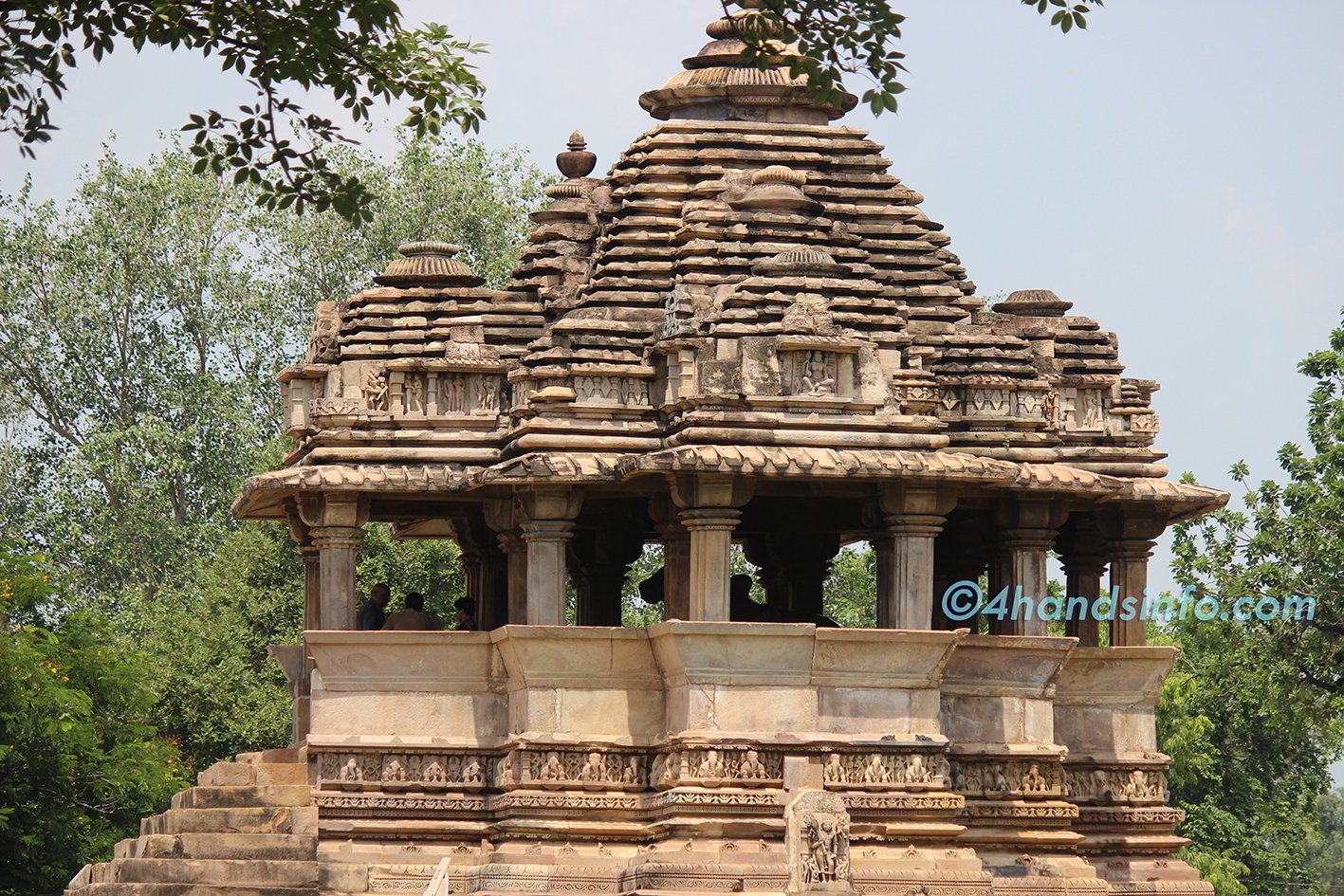
As to write a blog about “Khajuraho” there is an inspiration from September 2014 when I was stay whole the month in khajurao and Orchha and visited all the possible places from my Madhya Pradesh tour, that is the reason to share my experiences through the blog and images, and would love to hear your thoughts on this article, Can you share some of your own personal stories and advice? We would appreciate it if you could leave a comment below. Thank you for reading and visit my page.
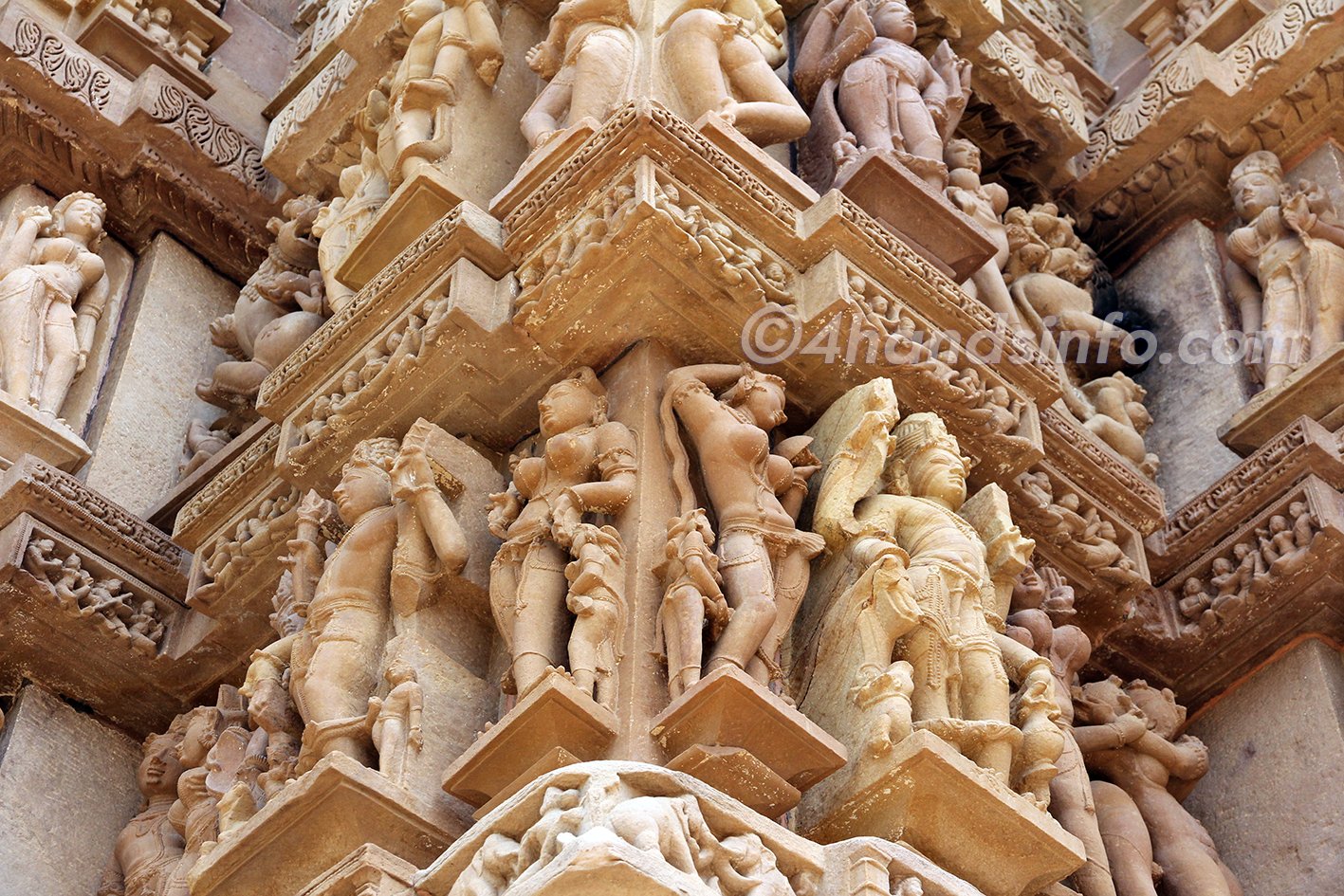
After reading our history we understand that the 85 temples are the History of Khajuraho remains of only 25 of these temples survive.
